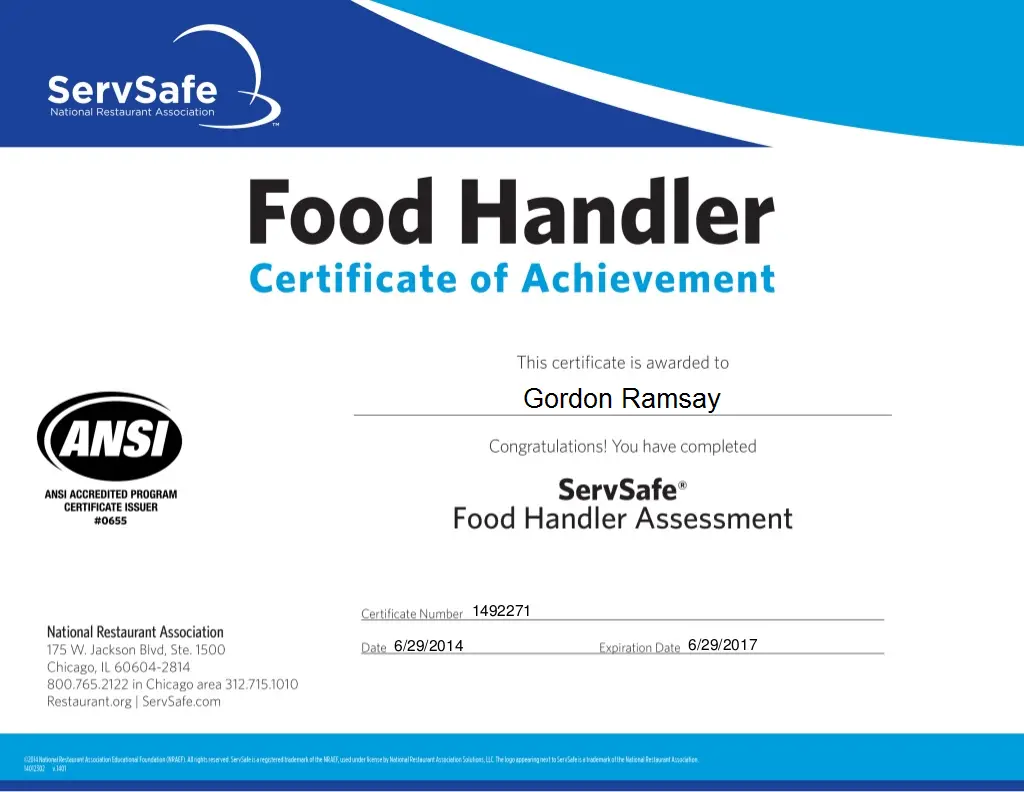Meals handler certifications idaho – Meals handler certifications in Idaho play a pivotal function in safeguarding public well being and upholding meals protection requirements. Working out the necessities, advantages, and penalties of certification is the most important for meals institutions and people dealing with meals.
In Idaho, meals handler certification is obligatory for more than a few meals institutions. The method comes to attending licensed coaching classes and passing an examination. Certification complements meals protection practices, boosts profession alternatives, and protects companies from felony liabilities.
Meals Handler Certification Necessities in Idaho

To verify the protection and high quality of meals served in Idaho, the state mandates meals handler certification for people running in explicit meals institutions. This certification verifies that meals handlers possess the vital wisdom and abilities to forestall foodborne sicknesses.
The next forms of meals institutions in Idaho require qualified meals handlers:
- Eating places
- Cafeterias
- Caterers
- Grocery shops with deli or bakery departments
- Meals vans
- College cafeterias
- Nursing houses
- Hospitals
Meals handler certification in Idaho should be renewed each and every 3 years. This guarantees that meals handlers keep up-to-date on absolute best practices and meals protection laws.
Acquiring Meals Handler Certification in Idaho
To verify meals protection and offer protection to public well being, people dealing with meals in Idaho should download a meals handler certification. The certification procedure comes to finishing an licensed coaching direction and passing an examination.
Licensed Meals Handler Coaching Suppliers
The Idaho Division of Well being and Welfare (DHW) approves meals handler coaching suppliers. An inventory of licensed suppliers can also be discovered at the DHW web site.
Content material of Meals Handler Coaching Classes
Meals handler coaching classes usually duvet the next subjects:
- Foodborne sicknesses and their prevention
- Private hygiene and sanitation
- Meals garage and preparation
- Cleansing and disinfecting
li>Pest regulate
Advantages of Meals Handler Certification

Acquiring a meals handler certification in Idaho provides a large number of benefits to people and meals institutions. It empowers meals handlers with the information and abilities to verify meals protection, complements meals protection practices, and opens up profession alternatives.
Enhanced Meals Protection Practices, Meals handler certifications idaho
Meals handler certification promotes meals protection by means of equipping people with complete coaching on right kind meals dealing with ways. Qualified meals handlers are well-versed in fighting foodborne sicknesses by means of adhering to established meals protection protocols, similar to:
- Keeping up right kind hand hygiene
- Fighting cross-contamination
- Storing meals at suitable temperatures
Through following those practices, qualified meals handlers give a contribution considerably to decreasing the chance of foodborne sicknesses, safeguarding public well being.
Advanced Occupation Alternatives
Within the aggressive meals trade, meals handler certification is increasingly more known as a treasured asset. Qualified people exhibit their dedication to meals protection and their determination to offering top of the range meals merchandise. This certification can strengthen task possibilities and open doorways to profession development alternatives throughout the foodservice sector.
Many employers in Idaho choose to rent meals handlers who possess a legitimate certification, because it signifies their wisdom and adherence to meals protection laws. This certification is usually a differentiator in securing employment and advancing one’s profession within the meals trade.
Penalties of Non-Compliance

Running a meals established order with out qualified meals handlers poses vital dangers to public well being and can result in critical penalties.
Failure to conform to meals handler certification necessities may end up in:
Consequences and Fines
- Financial fines starting from masses to hundreds of greenbacks
- Suspension or revocation of meals established order license
Significance of Compliance
Compliance with meals handler certification is the most important for keeping up a secure and wholesome meals surroundings. Qualified meals handlers have the information and abilities to:
- Save you foodborne sicknesses by means of training right kind meals dealing with and hygiene ways
- Establish and file possible meals protection hazards
- Give a contribution to the whole protection and recognition of the meals established order
Further Sources: Meals Handler Certifications Idaho
For additional help with meals handler certification in Idaho, seek the advice of the next assets:
Get admission to detailed knowledge, coaching fabrics, and certification tips from those respected resources.
Executive Companies
- Idaho Division of Well being and WelfareWeb site: https://healthandwelfare.idaho.gov/your-health-and-safety/food-safety Telephone: (208) 334-5800
- Idaho State Board of TrainingWeb site: https://www.sde.idaho.gov/subject-areas/health-and-physical-education/nutrition-services Telephone: (208) 332-6800
Trade Associations
- Idaho Eating place AffiliationWeb site: https://www.idahorestaurants.org/ Telephone: (208) 345-4678
- Idaho Grocers AffiliationWeb site: https://www.idahogrocers.org/ Telephone: (208) 344-3881
Coaching Suppliers
- ServSafeWeb site: https://www.servsafe.com/ Telephone: (800) 765-2122
- Nationwide Eating place Affiliation Instructional BasisWeb site: https://www.nraef.org/ Telephone: (312) 715-1010
Questions Continuously Requested
Is meals handler certification required for all meals institutions in Idaho?
No, most effective sure forms of meals institutions require qualified meals handlers, similar to eating places, catering companies, and meals processing amenities.
How continuously do meals handler certifications wish to be renewed in Idaho?
Meals handler certifications in Idaho are legitimate for 5 years and should be renewed inside of 30 days of expiration.
What are the effects of working a meals established order with out qualified meals handlers?
Running a meals established order with out qualified meals handlers may end up in fines, license suspensions, or even prison fees.

